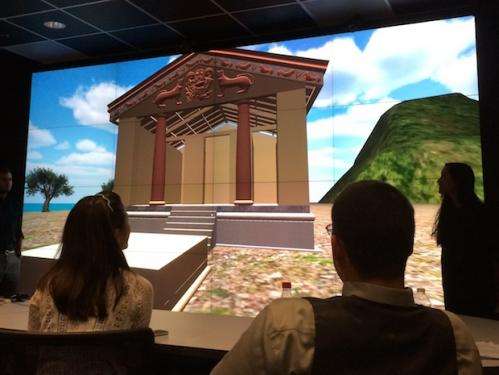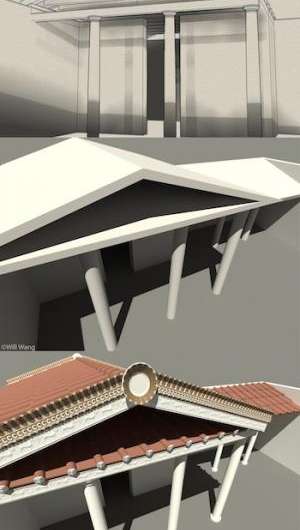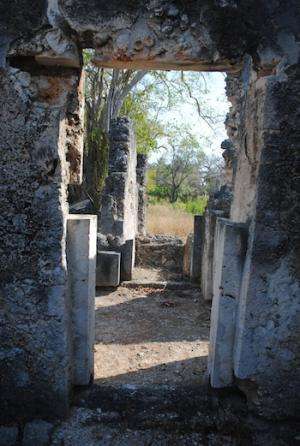Walks with the ancients: Reconstructing Roman, Swahili buildings through interactive, 3-D computer models

Senior Muhammad Shamim worked his way around the 15th-century Swahili residence like he knew it inside and out—because he did. He helped build it.
While his teammates described the residence that once existed physically, the Rice University computer science student walked an audience through the virtual grounds displayed on the giant DAVinCI Visualization Wall.
Gamers might have recognized the blocky structure's style as something out of a first-person shooter, but this was no game. It was a remarkable contribution to the science of archaeology.
Fifteen Rice students participated in a unique interdisciplinary project this semester to construct interactive 3-D computer models that bring the structures of ancient Roman and Swahili buildings to life, based on every scrap of archaeological and historical data they could gather. (Try them for yourself at the course website.)
The purpose was to test what the archaeological record could tell researchers about what such buildings might have looked like and to detail their construction techniques, as well as to get a feel for what it was like to live there.
Also unique was that the class drew students from across four schools at Rice: the School of Social Sciences (anthropology/archaeology), the School of Humanities (art history), the School of Architecture and the George R. Brown School of Engineering (computer science).
"It is rare to have four different schools at Rice sign off on such a collaborative course; in fact, I don't know if it's ever been done before," said John Hopkins, an assistant professor of art history and classical studies, whose specialty is ancient Roman art and architecture.
Hopkins and Jeffrey Fleisher, an associate professor of anthropology, co-led the course that brought together three teams of five undergraduates with at least one from each of the four schools. All their talents and collaborative skills were needed to bring to life two Swahili residences from the ruins of the ancient East African port of Songo Mnara, the site of an ongoing dig under Fleisher's direction, and a temple (at Sant'Omobono) and a residence/cult space (the Regia) from sixth-century B.C. Rome.
The teams capped their projects with a final presentation at Rice's Chevron Visualization Laboratory April 22, at which students described their roles in creating the models and answered questions about the models from classmates and visitors. (Funding by the lab's overseer, Rice's Ken Kennedy Institute for Information Technology, made the course possible, Fleisher said.)
Fleisher said he had been thinking about interactive models of archaeological sites for years. "A number of faculty members at Rice have been having these conversations about digital reconstruction," he said. "Two years ago, when John came here, we batted this around and finally said, 'Enough. We're just going to jump in and try it.'"

"Last year, we put together a workshop at the Humanities Research Center and hosted a scholar from UCLA who runs a lab like this," Hopkins added. "His advice was to stop dawdling. He said, 'It's going to be messy, but that's how you have to start.'"
Finding students in their own departments was straightforward. "The challenge was finding architects and computer scientists who were willing to say, 'Yeah, this is something we'd like to play a role in,' because it doesn't contribute much to their core classes," Fleisher said.
Hopkins said researchers on each team – the archaeology and art history students – began the semester with little to no information about their subjects, with the exception of one who had been on a dig to the African site. "They were expected, within four weeks, to present all the material on the building with as much expertise as possible," he said.
The researchers handed data off to architects, who built three-dimensional models. "The architectures would have questions or concerns like, 'This section is not roofable. Whatever your research might have said and whatever scholars have said in the past, this is impossible to do,'" Hopkins said.
"That forced us to ask questions about what kind of buildings were possible, given what we know about construction techniques at the time," he said.
Despite their having plenty of data about Roman roofs typical of the period, one building gave a team fits, Hopkins said. "When you look at the (two-dimensional floor) plan, you're not forced to think about certain issues, and so you don't." The Regia, he said, "had a set of rooms with an odd configuration for a Roman building. It was remarked upon by Roman scholars, but that was it.
"Well, the researchers did their plan, the architects did a massing model and everything was fine. But when the architect started on the roof, he realized there was no arrangement of rafters and purlins that would work – unless it was a truly unique roof. So he sent it back to the researchers."
The conclusion: The archaeology was sound, and so was the data. "That meant there were two options: Either there was not a roof, which was unlikely, or it had this strange-looking, unique roof. And this is something that's never entered the scholarship. Nobody's ever thought about this," Hopkins said.
Modeling software that only likes sharp angles also gave the architects heartburn, said sophomore Greg Kamback, a member of one of the Swahili teams. "Another program called Blender, which is a little more freeform, allowed us to manipulate the surfaces and objects to get more of a natural curve," he said. "But typically, the software we use as architects is completely straight."

With the static 3-D models done, Shamim and his peers in computer science went to work building the virtual worlds with open-source software normally used to build videogames. "But it wasn't like we were done," said senior Grace Apfeld, the archaeology student who spent six weeks last summer at the African dig and is writing her honors thesis about Swahili homes. "There was constant communication about the details."
The programmers were also charged with adding metadata to the models so users could click on a feature and get explanations, photos, graphics and other helpful information.
That helped when the teams had to make their best-educated guess about a particular feature. "For one of the Roman buildings, we know there was a statue of a bull on the roof. We know that because we have the hoof," Hopkins said. The options for the modelers were to put a bull on the roof – or not, "and based on the scholarship, both of those choices are misleading." The ability to add data-on-demand to the models allows a bit of intellectual wiggle room by ghosting a feature, or providing an indication of what might or might not have been there, he said.
"I think the idea is to work from the best data we can," Fleisher said. "But there is an element, in order to fully reconstruct the house, of making a guess that at least has the ring of truth to it."
Fleisher and Hopkins will teach the course again if time and workloads permit, but ultimately they would like to form a center where all the disciplines on campus can come together to study the ancient world.
Fleisher said seeing 3-D models based on his Swahili research was a revelation. "I can say, 'Is that right? I never would have pictured it that way.' And I've been working there for 20 years. Seeing reconstructions really does change the way we think about the archaeology," he said.
"The ultimate goal is to use these reconstructions as research tools, to challenge our understanding about domestic spaces by being able to inhabit them in three dimensions."
More information: The interactive models are available online: agt2.web.rice.edu/virtualrecon … .rice.edu/index.html
Provided by Rice University




















